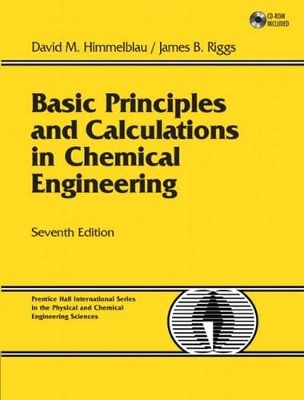
Basic Principles and Calculations in Chemical Engineering
Prentice Hall
978-0-13-140634-6 (ISBN)
- Titel erscheint in neuer Auflage
- Artikel merken
DAVID M. HIMMELBLAU is Paul D. & Betty Robertson Meek and American Petrofina Foundation Centennial Professor in Chemical Engineering at the University of Texas, Austin. He is author of sixteen books. JAMES B. RIGGS, Professor in the Chemical Engineering Department at Texas Tech University, directs the Texas Tech Process Control and Optimization Consortium. His books include Chemical Process Control, Second Edition and An Introduction to Numerical Methods for Chemical Engineers, Second Edition.
Preface.
Read Me.
Frequently Asked Questions.
I. INTRODUCTION.
1. Dimensions, Units, and Their Conversion.
Units and Dimensions. Operations with Units. Conversion of Units and Conversion Factors. Dimensional Consistency (Homogeneity). Significant Figures. Validation of Problem Solutions.
2. Moles, Density, and Concentration.
The Mole. Density. Specific Gravity. Flow Rate. Mole Fraction and Mass (Weight) Fraction. Analyses of Multicomponent Solutions and Mixtures. Concentration.
3. Choosing A Basis.
4. Temperature.
5. Pressure.
Pressure and Its Units. Measurement of Pressure. Differential Pressure Measurements.
II. MATERIAL BALANCES.
6. Introduction to Material Balances.
The Concept of a Material Balance. Open and Closed Systems. Steady-State and Unsteady-State Systems. Multiple Component Systems. Accounting for Chemical Reactions in Material Balances. Material Balances for Batch and Semi-Batch Processes.
7. A General Strategy for Solving Material Balance Problems.
Problem Solving. The Strategy for Solving Problems.
8. Solving Material Balance Problems for Single Units without Reaction.
9. The Chemical Reaction Equation and Stoichiometry.
Stoichiometry. Terminology for Applications of Stoichiometry.
10. Material Balances for Processes Involving Reaction.
Species Material Balances. Element Material Balances. Material Balances Involving Combustion.
11. Material Balance Problems Involving Multiple Units.
12. Recycle, Bypass, Purge, and the Industrial Application Of Material Balances.
Introduction. Recycle without Chemical Reaction. Recycle with Chemical Reaction. Bypass and Purge. The Industrial Application of Material Balances.
III. GASES, VAPORS, LIQUIDS, AND SOLIDS.
13. Ideal Gases.
The Ideal Gas Law. Ideal Gas Mixtures and Partial Pressure. Material Balances Involving Ideal Gases.
14. Real Gases: Compressibility.
15. Real Gases: Equations of State.
16. Single Component Two-Phase Systems (Vapor Pressure).
Phase Diagrams. Modeling and Predicting Vapor Pressure as a Function of Temperature.
17. Two-Phase Gas-Liquid Systems (Saturation, Condensation, and Vaporization).
Saturation. Condensation. Vaporization.
18. Two-Phase Gas-Liquid Systems (Partial Saturation and Humidity).
Terminology Involved for Partial Saturation. Material Balance Problems Involving Partial Saturation.
19. The Phase Rule and Vapor-Liquid Equilibria.
The Gibbs Phase Rule. Vapor-Liquid Equlibria in Binary Systems.
20. Liquids and Gases in Equilibrium with Solids.
IV. ENERGY BALANCES.
21. Energy: Terminology, Concepts, and Units.
The Terminology Associated with Energy Balances. Types of Energy.
22. Introduction to Energy Balances For Processes Without Reaction.
The Concept of the Conservation of Energy. Energy Balances for Closed, Unsteady-State Systems. Energy Balances for Closed, Steady-State Systems. Energy Balances for Open, Unsteady-State Systems. Energy Balances for Open, Steady-State Systems.
23. Calculation of Enthalpy Changes.
Phase Transitions. Heat Capacity Equations. Tables and Charts to Retrieve Enthalpy Values. Computer Databases.
24. Application Of Energy Balances in the Absence of Chemical Reactions.
Simplifications of the General Energy Balance. The Strategy for Solving Energy Balance Problems. Application of the Energy Balance to Closed Systems. Application of the Energy Balance to Open Systems.
25. Energy Balances: How to Account for Chemical Reaction.
The Standard Heat (Enthalpy) of Formation. The Heat (Enthalpy) of Reaction. Merging the Heat of Formation with the Sensible Heat of a Compound in Making an Energy Balance. The Heat of Combustion.
26. Energy Balances That Include the Effects of Chemical Reaction.
Analysis of the Degrees of Freedom to Include the Energy Balance with Reaction. Applications of Energy Balances in Processes that Include Reactions.
27. Ideal Processes, Efficiency, and the Mechanical Energy Balance.
Ideal Reversible Processes. Efficiency. The Mechanical Energy Balance.
28. Heats of Solution and Mixing.
Heats of Solution, Dissolution, and Mixing. Introducing the Effects of Mixing into the Energy Balance.
29. Humidity (Psychrometric) Charts and Their Use.
Terminology. The Humidity (Psychrometric) Chart. Applications of the Humidity Chart.
V. SUPPLEMENTARY MATERIAL (ON THE ACCOMPANYING CD)
30. Analysis of the Degrees of Freedom in a Steady-State Process.
31. Solving Material and Energy Balances Using Process Simulators (Flowsheeting Codes).
32. Unsteady-State Material and Energy Balances.
VI. APPENDICES.
A. Answers To Self-Assessment Tests.
B. Atomic Weights and Numbers.
C. Table of the Pitzer Z0 and Z1 Factors.
D. Physical Properties of Various Organic and Inorganic Substances.
E. Heat Capacity Equations.
F. Heats of Formation and Combustion.
G. Vapor Pressures.
H. Heats of Solution and Dilution.
I. Enthalpy-Concentration Data.
J. Thermodynamic Charts.
K. Physical Properties of Petroleum Fractions.
L. Solution of Sets of Equations.
M. Fitting Functions to Data.
N. Answers to Selected Problems.
Index.
| Erscheint lt. Verlag | 19.12.2003 |
|---|---|
| Verlagsort | Upper Saddle River |
| Sprache | englisch |
| Maße | 240 x 134 mm |
| Gewicht | 1720 g |
| Themenwelt | Technik ► Umwelttechnik / Biotechnologie |
| ISBN-10 | 0-13-140634-5 / 0131406345 |
| ISBN-13 | 978-0-13-140634-6 / 9780131406346 |
| Zustand | Neuware |
| Haben Sie eine Frage zum Produkt? |
